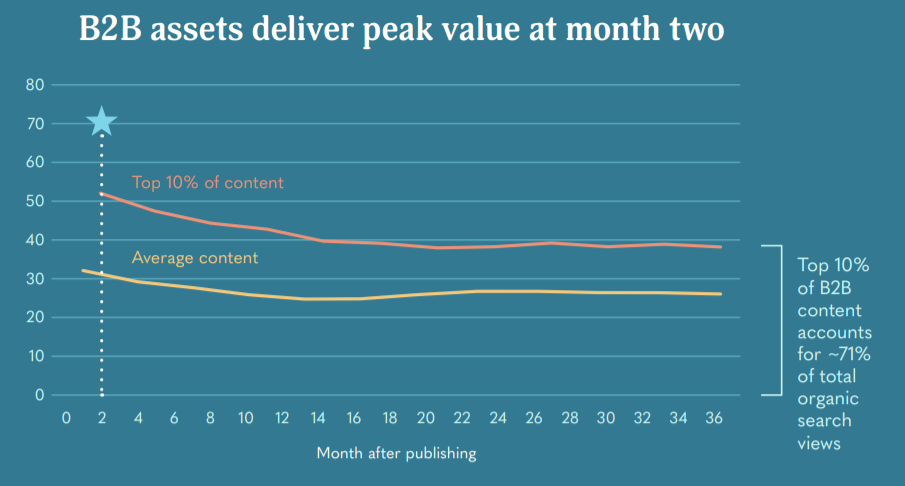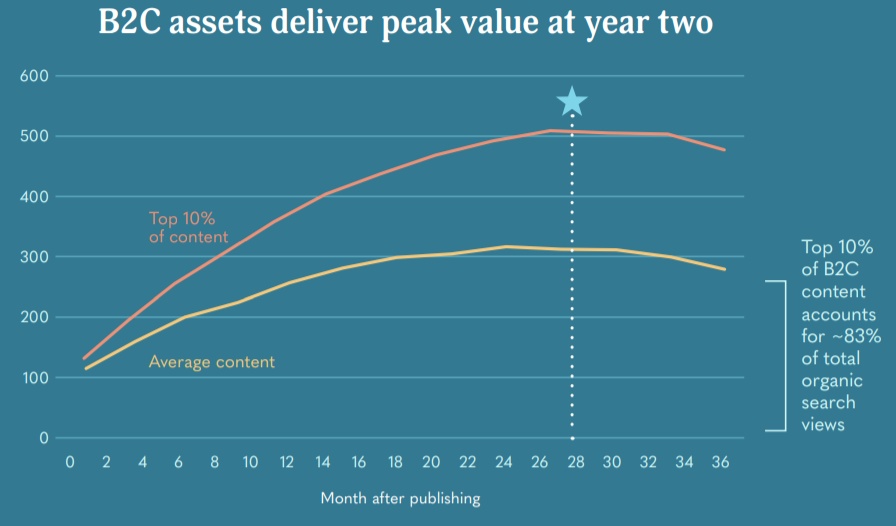Content Strategy
From Consistent Publishing to Performance Peaks: What You Need to Know About the Life Span of Content
By Jonathan Crowl on February 19, 2020
Hitting publish is the end of the content creation process but just the beginning of a much larger journey: an asset's mission to generate value for your brand. This value can look a lot different over time, depending on the type of content you've created, your consistent publishing practices, and other marketing strategies you're using to support content after it's published.
Organic search value is still a huge factor when determining the ROI of content marketing efforts. It's true that content loses some of this value over time, as newer published assets target the same keywords and audience. But there are a few misconceptions about how B2B and B2C content performs over time that could be affecting both your distribution and management strategy.
In our latest report, The Compounding Value of Publishing, we reveal several surprising insights on that front that organizations can use to improve the long-term value of their content. Here's a look at some of the report's biggest takeaways, and how you can use them to enhance your brand's content strategy.
B2B Content Sees Early Peaks, Steady Endurance
When comparing B2B and B2C content, we found significant differences in their life spans and peak organic search visibility. It's important to note that in either case, the peak value of a single piece of content wasn't reached right after its publication--even when looking at the top 10 percent of all B2B content.
B2B content typically reaches its peak organic search volume about two months after publication. This is important to consider when you're formulating a distribution strategy. If you use paid search to extend the life span of content and account for diminished organic search value, for example, you may want to avoid these peak periods where organic exposure is at its highest.

After that peak around the second month, B2B content experiences a gradual decline in organic search traffic. It doesn't drop significantly; instead, it settles into a steady rhythm that carries on beyond the three-year mark. The organic search volume experienced during this decline still delivers significant value to an organization, meaning that content created today can have a significant impact on long-term strategies and ROI.
B2C Content Sees Steady Growth, Long Arc
Compared to B2B content, B2C content sees a stark difference in life span performance value that will require a different approach to content strategy and distribution over time. Most notably, B2C content takes much longer to reach its peak organic search traffic. In fact, peak performance isn't reached until after the two-year mark.

After that peak, content experiences a steady but gradual decline in organic search views. This may be a frustrating prospect when creating a B2C content strategy, since the timeline for generating ROI on your efforts is so long. But by understanding this full life cycle, you can build a strategy that leverages this organic search arc and improves the performance and longevity of your content.
How to Extend the Longevity of Your Content
Results for content marketing efforts won't come overnight. A consistent publishing schedule helps ensure that you always have content hitting these peak performance windows, providing your company with a steady flow of organic search traffic.
You can even schedule publishing around keywords, funnel stages, and/or personas so that your content hits both its peak value window and audience targets. This minimizes gaps in your content strategy and enables more consistent visibility for your brand.
You can also extend the life span of your efforts by placing a greater emphasis on publishing blog content with evergreen value. If you have content that ages over time, such as listicles featuring the latest research and data relevant to your vertical, you can refresh this content with periodic updates to reset its timeline and generate more value at a nominal resource cost.
Similarly, look for opportunities to create new content off of an existing topic, especially as new circumstances or business challenges emerge. Cross-link between original and updated pieces to increase traffic and bolster search rankings, and keep tabs on your top-performing content so you can redistribute it when it becomes relevant again to your audience.
When publishing blog content, remember, it delivers ROI over time. This means marketers will need to play the long game when building a successful content strategy. Understanding the nature of these life cycles is critical to capitalizing on their movement over time.
Our report lays out the timelines you should be anticipating, which can help you build a strategy that maximizes the value of content and its organic visibility over time--whether it hails in the B2B or B2C landscape. Download the full report here.
Featured image attribution: Christina Morillo on Pexels.
